by Steve Selden | Sep 20, 2016 | Churchill News
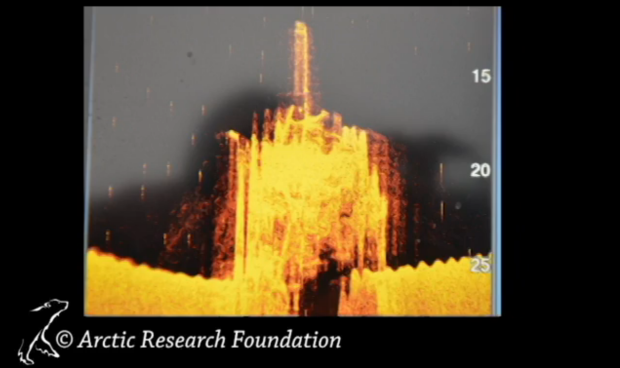
A scanned image of the HMS Terror submerged in Nunavut. Arctic Research Foundation image.
Just over a week ago the second piece of the 1845 ill – fated Franklin expedition was found in Terror Bay, Nunavut on the southern shore of King William Island. The illusive second grande puzzle piece of the expedition mystery was found in about 70 feet of water.
The Terror, abandoned in thick sea ice three years after it set sail from England in 1845, failed in its attempt to sail through the Northwest Passage. The wooden ship was discovered in “pristine condition” in a calm bay north of where the wreck of HMS Erebus was located in 2014.
Arctic Research Foundation’s Martin Bergmann research vessel located the shipwreck, with all three masts intact and standing while nearly all hatches closed.
“Resting proud on 24 metres of water, we found HMS Terror — 203 years old, it is perfectly preserved in the frigid waters of the Northwest Passage,” Arctic Research Foundation spokesman Adrian Schimnowski stated.
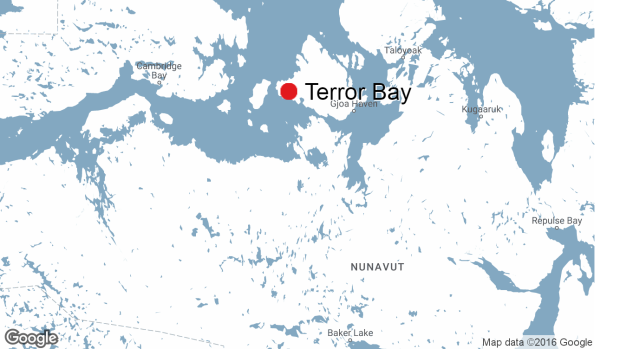
Location of the recently discovered HMS Terror. Google Maps image.
Trapped in ice somewhere between King William Island and Victoria Island the HMS Terror was found 92 kilometres south of that location. Bergmann’s crew decided to detour south to Terror Bay after an Inuk crew member, Sammy Kogvik from Gjoa Haven. Kogvik explained to the crew how during a fishing excursion about six years prior he sighted a rather large wood pillar extruding from the ice surface on Terror Bay.
“I was on my way to the lake to go put nets out,” Kogvik said in the Arctic Research Foundation’s video. “And when we got in the bay … as I was getting off the snowmobile, I looked up to my left, and there was something weird sticking out of the ocean on the ice.
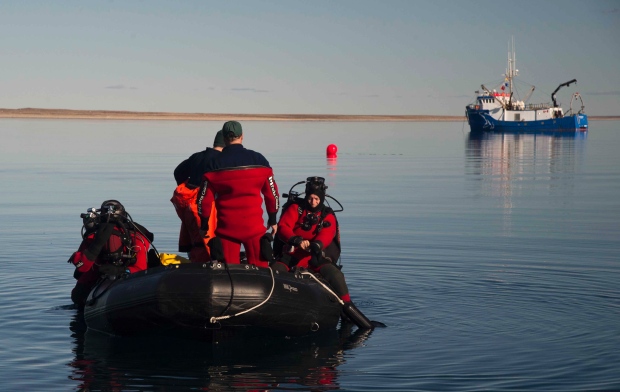
HMS Erebus dive site in 2014. Parks Canada photo.
“This is tremendously exciting news,” said Geiger. “The nature of the find, as reported, underscores also the vital role of the Inuit then and now in the Franklin saga.
The doomed expedition of nearly 170 years ago, tragically culminated in 129 deaths of crewmen. The Terror and Erebus lay locked in ice and submerged in water undiscovered until a search team, led by Parks Canada, unveiled the Erebus two years ago.
by Steve Selden | Apr 4, 2016 | Churchill News
Nunuvut’s government is staking claim to artifacts from the HMS Erebus – one of two ships from the ill – fated Sir John Franklin expedition of 1845. Nunavut is refusing to issue Parks Canada dive permits unless Parks Canada relinquishes rights to artifacts found and retrieved from the seabed at the wreck sight of the Erebus in the waters of Victoria Strait, just off the coast of King William Island where it was discovered in September 2014. The Erebus is thought to be the ship on which Franklin perished during the ill fated expedition. The other lost ship, HMS Terror has yet to be found.
Parks Canada finally relented to the Nunavut request after realizing their divers could face arrest by the RCMP. Permission from Nunavut’s director of heritage must now be consulted before retrieving any artifacts from the site.
In addition to Nunavut, other claimants to the Erebus’ artifacts include the Kitikmeot Inuit, who claim ownership under a land claims treaty, as well as the British, who, since the ships and expedition were of British origin, and based on an agreement drafted in 1997, possess rights to claim any artifacts of “outstanding significance” to their Royal Navy. The agreement between Canada and Britain recognize ownership of the wrecks and their contents by Britain, though it acknowledges Britain will ultimately gift ownership to Canada of everything, except gold, recovered from the wrecks.
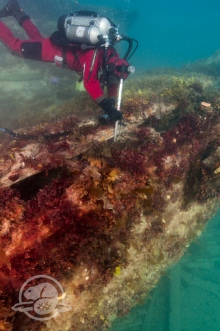
Parks Canada diver surveys the HMS Erebus. Parks Canada photo.
“During the permit application process for the spring 2015 ice dive on HMS Erebus, the government of Nunavut included a condition that denied Parks Canada the authorization to recover artifacts from the wreck site,” says a briefing note for Leona Aglukkaq, who was then the environment minister.
The federal cabinet has subsequently declared the HMS Erebus wreck and surrounding waters a national historic site, which took precedence over Nunavut’s permit regulations. However the wreck of the Terror, Franklin’s second lost ship is presumed to be outside the historical site designation therefore creating the same issues and subject to Nunavut’s initial claim of jurisdiction for the HMS Erebus artifacts.

Diver inspects the hull of the HMS Erebus preserved by the Arctic waters. Parks Canada photo.
This summer Parks Canada will return to the Erebus wreck site to document artifacts and then continue nearby areas to the north to search for the elusive HMS Terror as well. Hopefully all the ownership and jurisdiction tug – of – wars will ease enough to allow divers to expedite the process before the artifacts are scattered.
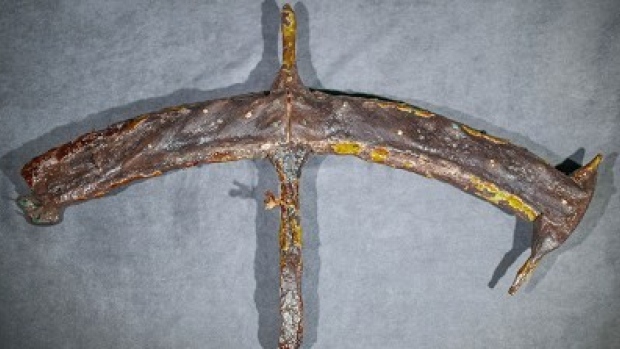
A portion of the Erebus steering wheel found at the site. Parks Canada photo.

A crewman’s boot in good condition was found at the site of the Erebus. Parks Canada photo.









